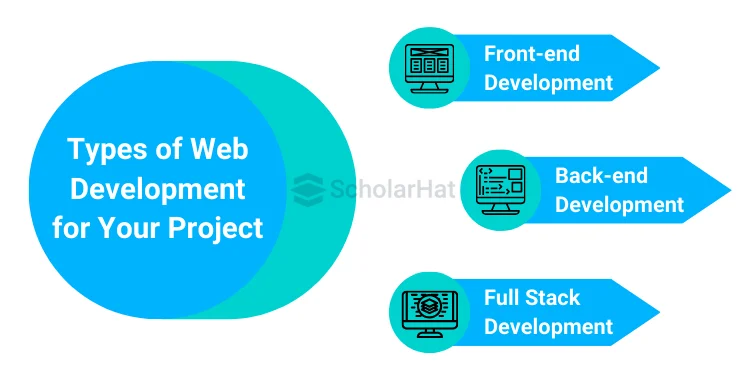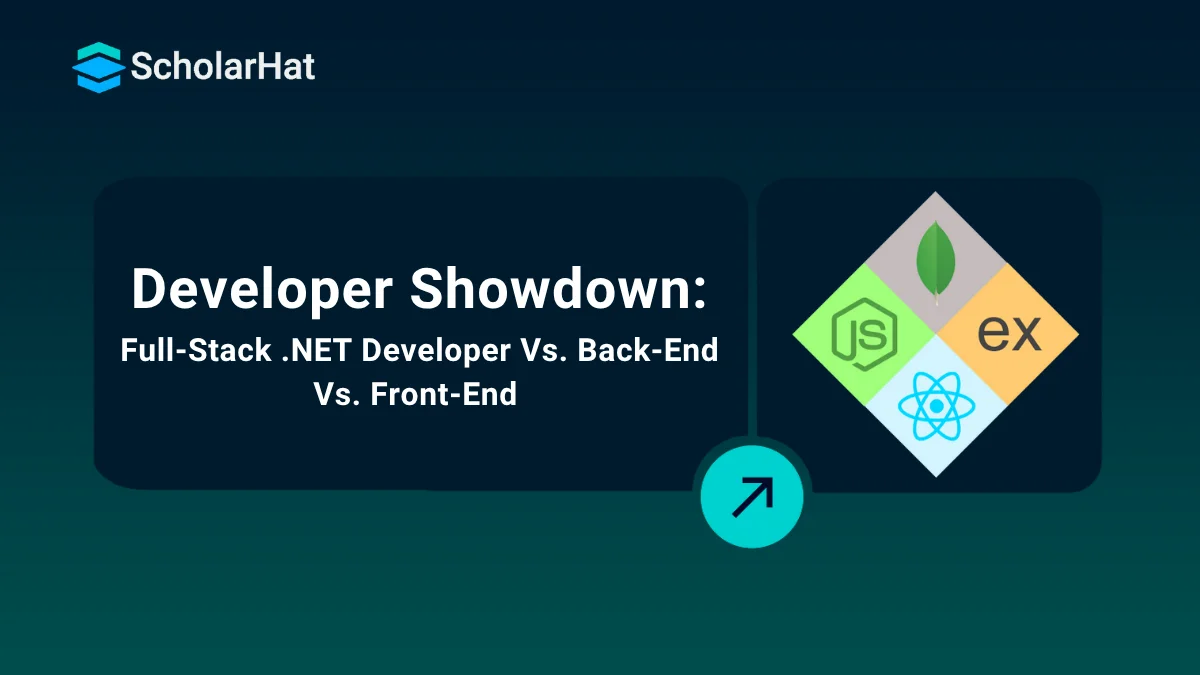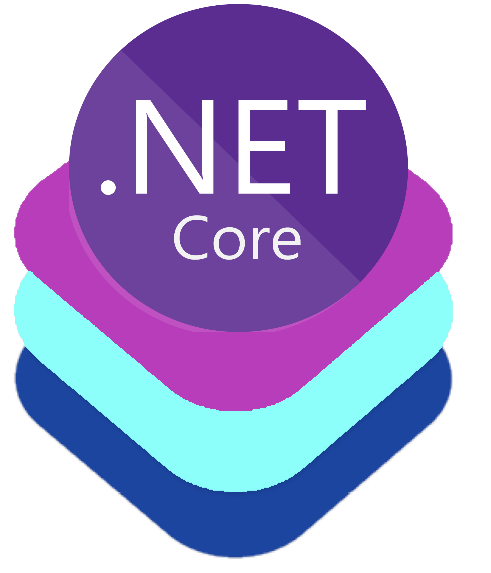08
JanFull-Stack .NET Developer Vs. Back-End Developer Vs. Front-End Developer
Front End, Back End, and Full Stack
Full Stack.NET Developer, Back End Developer, and Front End Developer roles play a main part in software development. Each position demands its own skills. Do you want to take a step in the software field along with full-stack positions? Yet, confused about which profile you should go with. Understanding the difference between full-stack .NET developer, back-end developer, and front-end developer will help you.
In this Full-Stack tutorial, you will analyze the Difference between Full-Stack .NET Developer, Back-End Developer, and Front-End Developer. Let's understand first what is web development.
Read More - Full Stack .Net Developer Salary Per Month
What is Web Development?
The process of building a website for the Internet is called web development. The non-design components of a website, such as features and functionality created with programming, markup, and scripting languages, are referred to as web development. The technical facets of developing websites, such as architecture, programming, graphics, and application integration, are the focus of developers.
A web developer is a person who
- Creates and manages web applications, including web pages.
- Creates a website from a web design
- They work with customers, stakeholders, and designers to understand the concept.
- able to focus on backend or frontend development. Even as a full-stack developer, if necessary
- Examine the many forms of web development now that you understand what it is.
Types of Web Development

FullStack.NET Developer
- A Full Stack .Net Developer is a programmer or technical person who can work within the software development process and is knowledgeable in the application's front and back end.
- In addition, a full-Stack .Net Developer must have good knowledge of databases, server configuration, and user interface.
- In simple words, a Full-Stack .Net Developer is a type of programmer who must have functional knowledge of all techniques, languages, and system engineering concepts required in Software development.
- The term “Full Stack” represents the technologies and skills needed to complete a project where each component is considered a stack. Stacks can be anything like mobile, web, or software specific.
- A Software Engineer always focuses on any part of the development process, i.e., either the front or back end.
- The front-end section considered all the components linked with the visible parts of the application.
- At the same time, the back end feels the related server-side business layer, database structure, and infrastructure.
- The Full-Stack concept is a hybrid of both.
- As full-stack developers, we need to know the different skills related to all the layers or stages involved in the application or software development.
- These skills typically contain other technology related to the front and back end.
- Besides this, Full-Stack developers may have the skills associated with Quality Assurance (QA), security, business intelligence (BI), and customer service.
Role and Responsibilities
- A FullStack.NET Developer is proficient, in frontend and backend development using the.NET framework.
- Their responsibilities include designing, coding, testing, and launching web applications.
- They connect user interfaces with server-side logic to ensure communication between the front-end and back-end.
| Read More: Full Stack Developer Interview Questions and Answers |
Key Skills and Technologies
1. Front-End
- HTML/CSS: Used for structuring and styling web pages.
- JavaScript: Adds interactivity and client-side logic.
- Blazor: Framework for creating web UIs with JavaScript.
2. Back-end
ASP.NET, C#, and.NET Core
You are an expert at using the .NET Core framework for server-side C# development. Building scalable and secure online applications is made easier with the help of ASP.NET's important tools and frameworks.
3. Databases
Entity Framework, SQL Server
With SQL Server, you can efficiently manage data by utilizing Entity Framework to facilitate database interactions and object-relational mapping (ORM).
4. DevOps
CI/CD, Azure:
With Azure, you can manage and deploy apps on the cloud while ensuring seamless updates and deployment through the use of continuous integration and deployment (CI/CD) techniques.
| Want to explore more about DevOps Explore our DevOps Certification |
| Azure DevOps Certification Training |
Advantages of Full-Stack .NET Developer
1. Adaptability
- The full stack.net skill set of developers is wide and includes both front-end and back-end technologies.
- Because of their adaptability, they can work on database management, server-side logic, and user interface design like all aspects of program development.
2. End-to-End Understanding
- Their in-depth knowledge of the complete software development lifecycle enables them to design unified, integrated solutions that support organizational objectives.
3. Effectiveness
- These developers don't need to rely on other team members to handle activities across different application layers, development cycles and deployment times are frequently accelerated.
4. Cost-effective
- Having a full stack might be advantageous for small to medium-sized projects.
Challenges for Full-Stack .NET Developer
1. Depth vs. Breadth
- When compared to specialist developers, a person who balances proficiency across numerous technologies may have a shorter understanding of certain subjects.
2. Learning Curve
- Staying current with new frameworks, tools, and best practices as well as ongoing education is necessary to keep up with advances in front-end and back-end technologies within the.NET ecosystem.
3. Scope creep
- In complex projects, the range of duties may make it difficult to set priorities, which may have an impact on the timely or high-quality delivery of particular components.
4. Resource Constraints
- Full-Stack.NET Developers may still need assistance or coordination with specialist professionals for intricate or highly specialized areas of development, even though they are capable of performing a variety of jobs.
Back-End Developer
- An expert software developer known as a back-end developer is responsible for creating and managing the databases, server-side logic, and application programming interfaces (APIs) that underpin online applications' functionality.
- In addition to managing the data interchange between the front-end (client-side) and back-end (server-side) systems, they operate in the background to guarantee that the server, database, and application all communicate with each other.
- A back-end developer's job responsibilities include the following:
Role and Responsibilities
1. Server-side logic
- Implementing the algorithms and logic that specify how an application operates is known as server-side logic.
- This entails handling front-end request processing, handling data operations, and providing pertinent answers.
2. Database Management
- Creating, maintaining, and utilizing databases is known as database management.
- This includes composing queries, building schemas, and guaranteeing data security and integrity.
3. Development and Integration of APIs
- APIs (Application Programming Interfaces) are the building blocks that enable communication between various software systems.
- This covers GraphQL as well as RESTful APIs.
4. Performance optimization
- It is the process of making sure the program operates effectively, managing heavy traffic loads, and reducing latency.
- This entails tweaking databases, implementing caching techniques, and optimizing code.
5. Security
- We are putting best practices for security into practice to shield application logic and data from vulnerabilities and unwanted access.
- Managing the authorization and authentication procedures is part of this.
Key Technologies and Skills
1. Programming on the server side
Java, Python, Ruby, C#, Node.js
- It is imperative to know at least one server-side programming language, such as Node.js, Java, Python, Ruby, C#, or Python.
- Web applications' business logic and functionality are developed using these languages.
2. Tables
SQL and NoSQL
- Developers use reverse databases to store, retrieve, and modify data.
- They know how to use NoSQL databases like MongoDB for handling unstructured data and SQL for relational databases like MySQL or PostgreSQL.
3. RESTful and GraphQL APIs
- They create and put into use APIs (Application Programming Interfaces) which facilitate communication between various software components. Most APIs are RESTful.
Advantages of a back-end developer
1. Specialization
- Because of backend developers' expertise in database administration and server-side programming, back-end developers are well-suited to handle intricate data operations and business logic.
2. Security
- In order to guard against vulnerabilities, they incorporate authentication, authorization, and data validation procedures.
- They concentrate on securing data and application logic on the server side.
3. Scalability
- When designing apps, back-end developers consider scalability to make sure that the server-side infrastructure can effectively manage growing traffic and data volumes.
Challenges for a back-end developer
1. Complexity
- Creating and managing databases and server-side logic can be difficult, requiring a thorough grasp of database design principles as well as software architecture.
2. Integration
- It can be difficult to guarantee smooth integration between front-end elements and back-end services, particularly in large-scale applications with several modules and APIs.
3. Performance Optimization
- Enhancing the functionality of the server to manage heavy traffic.
Front-End Developer
- A front-end developer is a professional engineer having responsibility for the end-to-end design and implementation of the interface layer for the application.
- The end user or the visitor of the application requires an interface so that they can access or interact with the application eventually.
- But the web designer is a professional engineer who creates a website’s look and feel such as the actual interface with the web elements.
- The front-end developers make sure that the required front-end designs work into the platform such as the browser by using the mark-up, stylesheet, and scripting languages such as CSS, HTML, and JavaScript.
Key Technologies and Skills
1. Programming Languages
javascript, CSS, and HTML
- proficiency with CSS (Cascading Style Sheets) for styling and layout, HTML (Hypertext Markup Language) for content organization, and JavaScript for interactive features and characteristics.
2. Frameworks
Angular, Vue.js, React
- familiarity with front-end frameworks and libraries that improve the functionality of front-end apps and speed up development, such as Angular, Vue, and React.js.
3. Responsive design and UX/UI
- Comprehending the principles of user interface (UI) and user experience (UX) design in order to develop user interfaces that are easy to use, approachable, and captivating.
- Understanding responsive design guarantees that user interfaces adjust to various screen sizes and devices with ease.
Advantages of front-end developer
- Focus on User Experience: Front-end developers are experts in designing user-friendly interfaces that make apps logical and captivating.
- Visual Creativity: They can utilize their imagination to create user interfaces that are aesthetically pleasing and consistent with brand standards.
Challenges for front-end developers
- Browser Compatibility: Because different web browsers and devices have different standards and capabilities, it might be difficult to guarantee consistent performance and appearance across them.
- Dependency on Back-End: Effective cooperation and communication are necessary since Front-End developers depend on Back-End developers for data access and business logic integration.
- Technological Evolution: To keep up with current trends and best practices, one must constantly learn and adapt to the rapid evolution of front-end frameworks and technologies.
Difference Between Front End and Back End and Full Stack
- FrontEnd Development concentrates on the client-side components of an application that users directly interact with. It encompasses crafting and implementing the interactive features of a website or application.
- Backend development revolves around server-side logic, databases, and application programming interfaces (APIs) that drive the end. It ensures an application's functionality, performance, and data integrity.
- FullStack Development melds frontend and backend development expertise to empower developers to work across the technology spectrum. Particularly, for a Full Stack.NET Developer who specializes in utilizing the.NET framework to construct solutions. Let's see the difference between Front End and Back End and Full Stack with different factors.
| Factors | Front end Developer | Back end Developer | Full Stack Developer |
| Technologies | A website's appearance and feel are the responsibility of front-end developers. The web pages and user interface are made with HTML, CSS, and JavaScript. | The server-side programs that power a website are written by back-end developers. They use technologies like REST. | Both front-end and back-end development are areas of expertise for full-stack developers. |
| Languages | JavaScript is the primary language used by front-end developers. | Python, Ruby on Rails, and PHP are among the languages used by back-end developers to power websites and applications. | Full-stack developers are capable of working at all stages of the web development process and possess a combination of both skill sets. |
| Job opportunities | Front-end Developers have more Jobs than back-end developers. | Back-end Developers have fewer jobs than front-end and full-stack developers. | For Full Stack Developer, there is the highest number of jobs available. |
| Tools | Atom and Sublime Text are two examples of text editors that front-end developers utilize. | Web servers, relational database management systems, and object-oriented programming languages are some of the technologies used by back-end developers. | To design dynamic websites and online apps, full-stack developers make use of all the front-end and back-end tools available, in addition to additional ones. |
| Skills Required | A front-end developer must possess good HTML, CSS, and JavaScript expertise. The fundamentals of user experience (UX) design should also be understood by you. | You need to be proficient in server-side languages like PHP, Ruby on Rails, or Node.js to work as a back-end developer. | So having expertise in both front-end and back-end programming is essential for a Full-Stack developer. |
| Salary Range | Front end Developer salary in India ranges between ₹ 1.2 Lakhs to ₹ 12.0 Lakhs with an average annual salary of ₹ 6.0 Lakhs | The estimated total pay for a Backend Developer is ₹8,70,000 per year, with an average salary of ₹8,00,000 per year. | The average salary for a Full Stack Developer is ₹7,00,000 per year in India. The average additional cash compensation for a Full Stack Developer in India is ₹75,000, with a range from ₹35,000 - ₹1,75,000. |
Conclusion
In summary, while each FullStack.NET Developer, BackEnd Developer, and FrontEnd Developer role has its own characteristics, they all function well together in the software development process. There is a role that fits your interests and skill set, whether you prefer to design user interfaces or create programs with a server-side logic focus. You may make more educated judgments regarding your career path in the IT industry if you are aware of these distinctions. However, if you want to make a career in full-stack or front, backend, Full-Stack .NET Developer Certification might help you.
| Explore our Roadmaps to becoming a web developer |
| Full Stack Developer Roadmap |
| Backend Developer Roadmap |
FAQs
Take our Fullstack skill challenge to evaluate yourself!

In less than 5 minutes, with our skill challenge, you can identify your knowledge gaps and strengths in a given skill.












